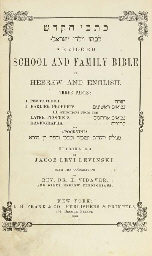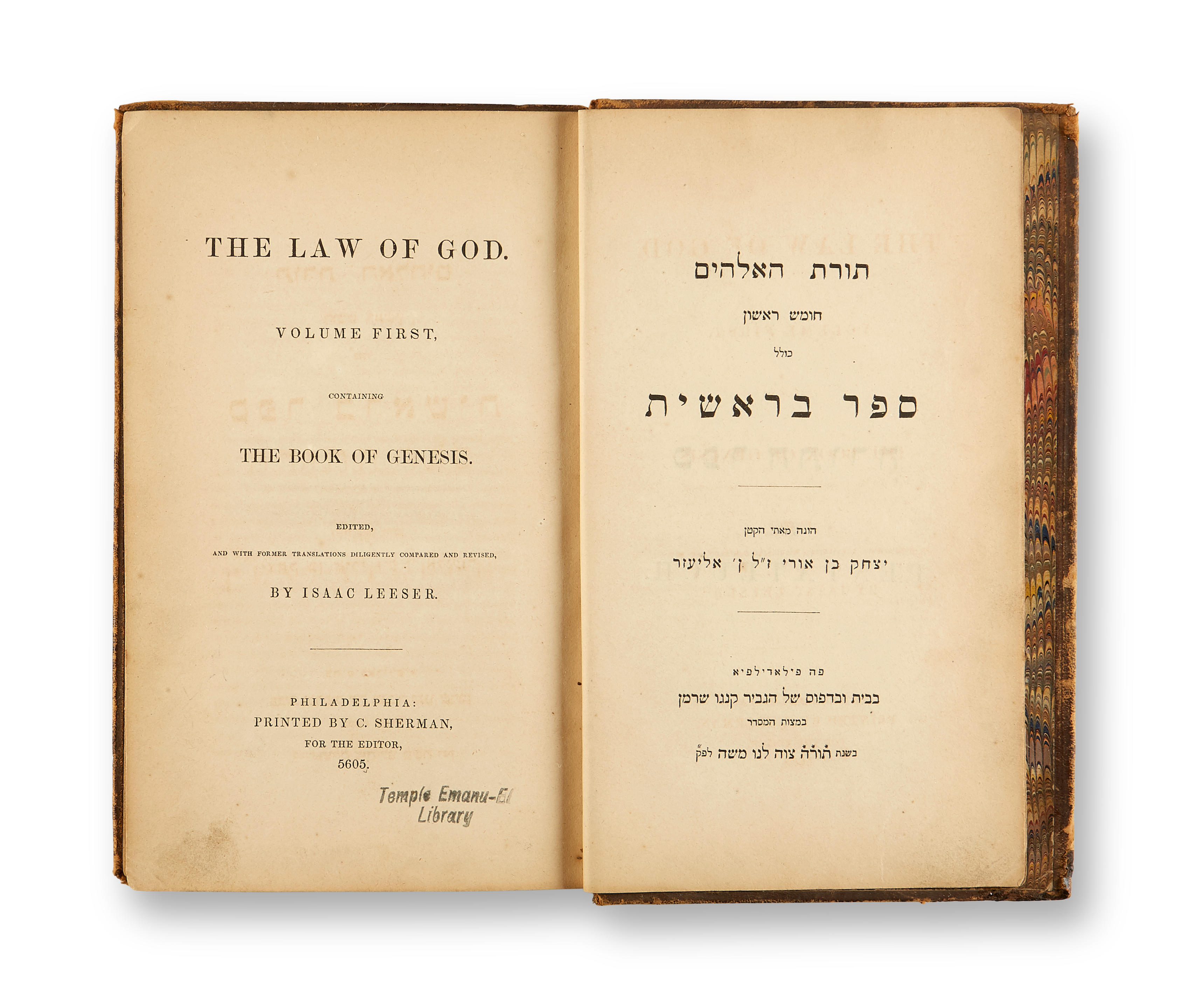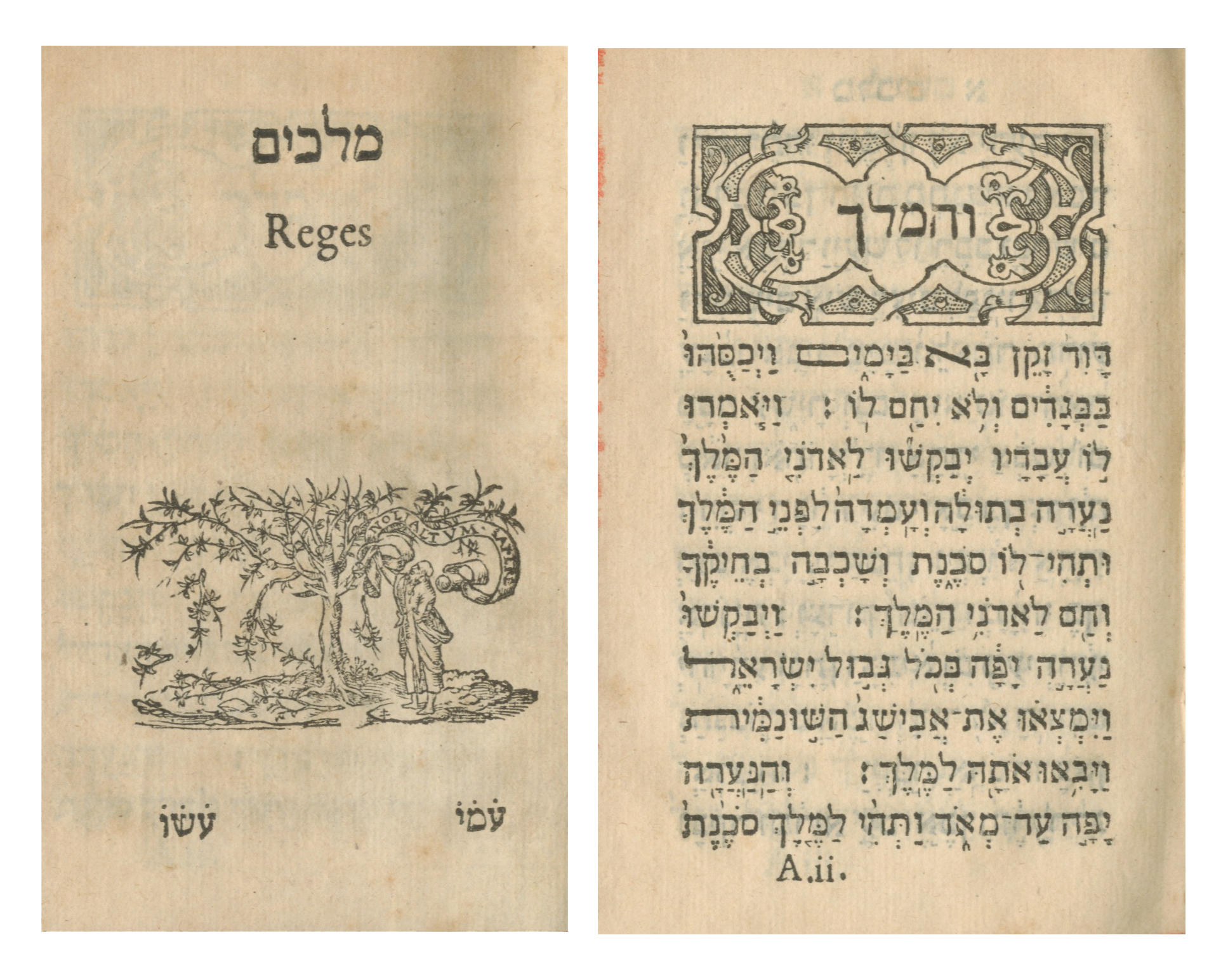BIBLE. HEBREW. PENTATEUCH Torah with the Targum of Onkelos and the commentary of Solomon ben Isaac [edited by Joseph Hayyim ben Aaron Strasbourg Zarfati]. Bologna: Abraham ben Hayyim, for Joseph Caravita, 25 January 1482 Chancery folio (329 x 235mm.), 170 leaves (of 220), collation of a complete copy: [1-410/8 58 610 7-88 96 1010 114 12-136 1410 158 166 17-208/10 218 224 238 246 2510 26-278 286], central text in large square characters surrounded by a smaller semi-cursive font for the supplementary texts, printed headlines, late eighteenth-century patterned paper boards, endpapers of laid paper watermarked with a fleur-de-lys in a crowned shield with a countermark of italic letters ("Jodi C"?), lacking 50 leaves (leaves 1-46 [Genesis 1-44:4], 87, 88, 121, and final blank), 188 misbound after 189, a few leaves slightly stained, spine covering torn with some quires starting to become loose, but OVERALL A GOOD, TALL AND CRISP COPY A GOOD COPY OF THE FIRST APPEARANCE OF THE HEBREW TEXT OF THE PENTATEUCH SHOWING EVIDENCE THAT IT WAS USED AS A MODEL FOR A PROFESSIONAL SCRIBE. It was this printing of Rashi's commentary that served as a model for all later editions. The Hebrew text is elegantly framed by an Aramaic translation (Targum of Onkelos) to the side and the commentary of Rashi (Solomon ben Isaac) at head and foot. Rashi's eleventh-century commentary on the Torah had been one of the first Hebrew books ever printed, in Rome in c. 1469-72, and was regularly reprinted; it also proved influential on later commentators such as Nicolaus of Lyra. The Targum of Onkelos, attributed to the first-century Roman convert to Judaism, is the authoritative paraphrase of the text into a western dialect of Aramaic (probably in Palestine, with subsequent Babylonian influence), and was considered important for the interpretation of the original Hebrew. The edition was proofread by Joseph Hayyim Zarfati, who also wrote the colophon. Abraham ben Hayyim began his printing career in Ferrara in around 1477, before moving to Bologna at the behest of the banker Joseph ben Abraham Caravita, who financed the printing of this Torah. Abraham is supposed to come from a family of dyers and textile printers, meaning that he was already familiar with printing techniques. He subsequently worked for the Soncino family of printers, with whom he worked on the first complete Hebrew bible in 1488. It is likely that he also produced an edition of the Five Megillot (Song of Songs, Ruth, Lamentations, Ecclesiastes and Esther) in Bologna around the same time (see ISTC ib00525980). The printing of Hebrew is hampered by the same problems as printing in Greek, with numerous diacritics (vowel points in Hebrew) to be accommodated; this is THE FIRST BOOK PRINTED WITH THE HEBREW TEXT FULLY VOCALISED AND WITH CANTILLATION MARKS. "It constitutes a remarkable technical achievement" (A. Offenberg, A Choice of Corals, 1992, p.141); Offenberg goes on to observe that it took Italian printers another ten years or so to develop a similarly successful Greek type face, and indeed postulates a connection between the Bolognese craftsman who finally created that Greek typeface, Francesco Griffo (c. 1450-1518), with Abraham ben Hayyim; certainly Griffo and Abrahim ben Hayyim worked together for the Soncino printing house after Griffo's dismissal by Aldus Manutius "Abraham ben Hayim's pioneering methods contributed considerably to the development of Hebrew printing" (BMC XIII, Hebraica, p. XLVII). This edition was printed on both vellum and paper, with most surviving copies being on vellum, as usual, and it is considered that the paper copies were printed first. ISTC records 36 substantial copies (along with 5 fragments), of which 21 are recorded as vellum copies. Additionally, two further copies have appeared for sale in recent years, a paper copy in 1998 and a vellum copy in 2014. The good survival rate of this edition compared with other contemporary Hebrew books, which often survive in jus
BIBLE. HEBREW. PENTATEUCH Torah with the Targum of Onkelos and the commentary of Solomon ben Isaac [edited by Joseph Hayyim ben Aaron Strasbourg Zarfati]. Bologna: Abraham ben Hayyim, for Joseph Caravita, 25 January 1482 Chancery folio (329 x 235mm.), 170 leaves (of 220), collation of a complete copy: [1-410/8 58 610 7-88 96 1010 114 12-136 1410 158 166 17-208/10 218 224 238 246 2510 26-278 286], central text in large square characters surrounded by a smaller semi-cursive font for the supplementary texts, printed headlines, late eighteenth-century patterned paper boards, endpapers of laid paper watermarked with a fleur-de-lys in a crowned shield with a countermark of italic letters ("Jodi C"?), lacking 50 leaves (leaves 1-46 [Genesis 1-44:4], 87, 88, 121, and final blank), 188 misbound after 189, a few leaves slightly stained, spine covering torn with some quires starting to become loose, but OVERALL A GOOD, TALL AND CRISP COPY A GOOD COPY OF THE FIRST APPEARANCE OF THE HEBREW TEXT OF THE PENTATEUCH SHOWING EVIDENCE THAT IT WAS USED AS A MODEL FOR A PROFESSIONAL SCRIBE. It was this printing of Rashi's commentary that served as a model for all later editions. The Hebrew text is elegantly framed by an Aramaic translation (Targum of Onkelos) to the side and the commentary of Rashi (Solomon ben Isaac) at head and foot. Rashi's eleventh-century commentary on the Torah had been one of the first Hebrew books ever printed, in Rome in c. 1469-72, and was regularly reprinted; it also proved influential on later commentators such as Nicolaus of Lyra. The Targum of Onkelos, attributed to the first-century Roman convert to Judaism, is the authoritative paraphrase of the text into a western dialect of Aramaic (probably in Palestine, with subsequent Babylonian influence), and was considered important for the interpretation of the original Hebrew. The edition was proofread by Joseph Hayyim Zarfati, who also wrote the colophon. Abraham ben Hayyim began his printing career in Ferrara in around 1477, before moving to Bologna at the behest of the banker Joseph ben Abraham Caravita, who financed the printing of this Torah. Abraham is supposed to come from a family of dyers and textile printers, meaning that he was already familiar with printing techniques. He subsequently worked for the Soncino family of printers, with whom he worked on the first complete Hebrew bible in 1488. It is likely that he also produced an edition of the Five Megillot (Song of Songs, Ruth, Lamentations, Ecclesiastes and Esther) in Bologna around the same time (see ISTC ib00525980). The printing of Hebrew is hampered by the same problems as printing in Greek, with numerous diacritics (vowel points in Hebrew) to be accommodated; this is THE FIRST BOOK PRINTED WITH THE HEBREW TEXT FULLY VOCALISED AND WITH CANTILLATION MARKS. "It constitutes a remarkable technical achievement" (A. Offenberg, A Choice of Corals, 1992, p.141); Offenberg goes on to observe that it took Italian printers another ten years or so to develop a similarly successful Greek type face, and indeed postulates a connection between the Bolognese craftsman who finally created that Greek typeface, Francesco Griffo (c. 1450-1518), with Abraham ben Hayyim; certainly Griffo and Abrahim ben Hayyim worked together for the Soncino printing house after Griffo's dismissal by Aldus Manutius "Abraham ben Hayim's pioneering methods contributed considerably to the development of Hebrew printing" (BMC XIII, Hebraica, p. XLVII). This edition was printed on both vellum and paper, with most surviving copies being on vellum, as usual, and it is considered that the paper copies were printed first. ISTC records 36 substantial copies (along with 5 fragments), of which 21 are recorded as vellum copies. Additionally, two further copies have appeared for sale in recent years, a paper copy in 1998 and a vellum copy in 2014. The good survival rate of this edition compared with other contemporary Hebrew books, which often survive in jus














.jpg?w=400)
Testen Sie LotSearch und seine Premium-Features 7 Tage - ohne Kosten!
Lassen Sie sich automatisch über neue Objekte in kommenden Auktionen benachrichtigen.
Suchauftrag anlegen